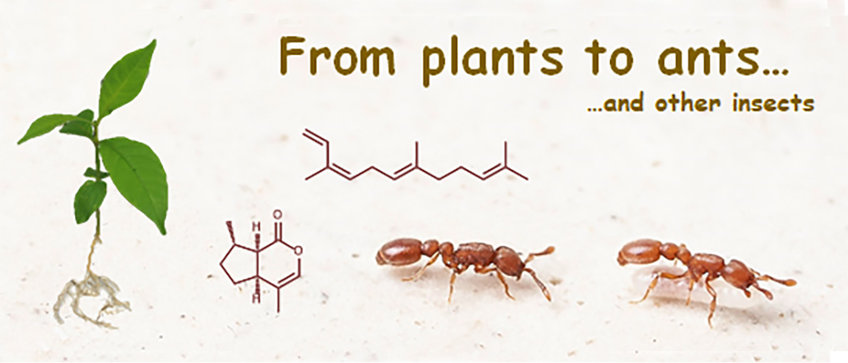
Pathway evolution
Independent evolution of benzoxazinoids in angiosperms

Matilde Florean, Susan Schlüter, Hedwig Schulz
Benzoxazinoids (BXDs) form a class of indole-derived plant defense compounds that occur sporadically in a number of distantly related plant orders. Decades of research in the grasses have led to the complete elucidation of the BXD metabolism in this monocot family; however, the biosynthesis of BXDs in eudicots is still unclear. Using a metabolome- and transcriptome-guided approach in combination with heterologous expression of candidate genes in Nicotiana benthamiana, we have previously elucidated the entire BXD pathway in two eudicot species. This work has shown that BXDs have arisen independently at least three times in the plant kingdom, through both parallel and convergent evolutionary events. We are now investigating the formation of BXDs in several other eudicots to gain deeper insights into the mechanisms of pathway evolution in plants.
Engineering artificial metabolic pathways
Susan Schlüter, Matilde Florean
Chemical modifications, such as the addition of halogen atoms, can enhance the pharmacological properties of natural products. However, such changes often require complex total syntheses. The construction of artificial pathways using enzymes with broad substrate specificity enables the production of modified natural products directly and cost-effectively in plants. We have started to investigate the potential of this approach using benzoxazinoids (BXDs) as an example by co-expressing a bacterial halogenase, a bacterial tryptophan lyase and various BXD genes in the heterologous host plant Nicotiana benthamiana. Next, we will optimize this system by targeting individual enzyme activities and improving the supply of biosynthetic precursors to increase the yield of halogenated BXDs.
Iridoid biosynthesis in aphids and ants
Gabriel Titchiner, Maithili Datta
Iridoid monoterpenes, which are widely distributed in plants and insects, have many ecological functions. While the biosynthesis of iridoids in plants has been extensively studied, little is known about how insects synthesize these natural products. We have begun to investigate the biosynthesis of iridoids in aphids, where they act as sex pheromones. The elucidation of the iridoid synthesis pathway in the pea aphid Acyrthosiphon pisum has shown that iridoids have evolved independently in plants and insects.

We are currently investigating the factors responsible for the different stereoselectivity of the iridoid pathways in A. pisum and the hop aphid Phorodon humuli. Ants also produce iridoids, most likely as defense and alarm pheromones. For example, the Argentine ant Linepithema humile and the Australian meat ant Iridomyrmex purpureus produce iridomyrmecin and cis,trans-iridodial, respectively. Sequencing the transcriptomes of these species revealed that the ants have no genes similar to the iridoid genes of aphids. We are now elucidating the iridoid pathway in L. humile and I. purpureus to understand how iridoids evolved in these insects.
Formation and function of terpenoids in the clonal raider ant

Tobias Köllner, Tim Zetsche, project in close collaboration with Yuko Ulrich
In recent years, the clonal raider ant Oocerae biroi has become established as a model system for studying various aspects of social behavior in insects. We were able to show that O. biroi produces a complex mixture of volatile compounds that probably act as pheromones. One of the dominant compounds was identified as (Z,E)-α-homofarnesene, and sequencing of the transcriptome of the Dufour gland, the site of terpene production in this species, revealed candidate genes for the biosynthesis of homofarnesene and other terpenes.
By knocking out these genes using a CRISPR-Cas system, we will
I) demonstrate the in vivo function of the enzymes they encode and
II) investigate the role of (homo)terpenes as signals for social behavior in this ant.
Biosynthesis of terpenoids and alkaloids in beetles and ants
Ryan Alam, Angeliki Stathaki, Matilde Florean, Gabriel Titchiner
The biosynthesis of natural products in plants, fungi and bacteria has been the subject of intense research for decades. Although insects also produce a rich arsenal of such compounds, virtually nothing is known about their formation. The identification and characterization of enzymes involved in the biosynthesis of natural products in insects will not only help to understand the evolution and role of these compounds, but will also provide the opportunity to discover interesting and novel enzymes for biotechnological applications. Here, we aim to study the formation of terpenoids and alkaloids in different beetles and ants. We are currently establishing an insect cell culture system as heterologous host for the simultaneous expression of genes encoding entire natural product pathways.


